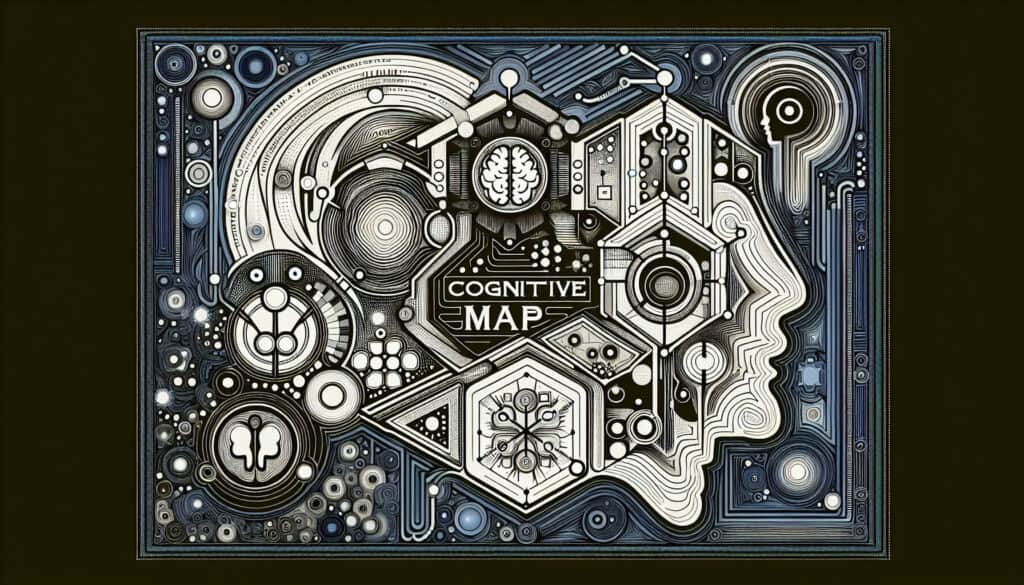Tipo de representación mental que sirve a un individuo para adquirir, codificar, almacenar, recordar y descodificar información sobre la ubicación relativa y los atributos de los fenómenos de su entorno espacial cotidiano o metafórico.
- Metodologías: Clientes y marketing, Ideación, Diseño de producto
Mapa cognitivo

Mapa cognitivo
- Computación cognitiva, Trayectoria del cliente, Proceso de diseño, Pensamiento de diseño, Diseño centrado en el ser humano, Diseño de interacción, Experiencia de usuario (UX), Interfaz de usuario (UI), Pruebas de usuario
Objetivo:
Cómo se utiliza:
- En diseño e investigación, es una herramienta de visualización utilizada para representar el modelo mental de una persona sobre un concepto o proceso concreto, a menudo con el aspecto de un diagrama de red o web.
Ventajas
- Ayuda a comprender el modelo mental y los procesos de pensamiento de un usuario, puede revelar conceptos erróneos u oportunidades para mejorar el diseño, y proporciona una visión rica y cualitativa de la comprensión de un usuario.
Contras
- Su creación y análisis pueden ser complejos y llevar mucho tiempo, la interpretación puede ser subjetiva y representa la perspectiva de una persona, que puede no ser generalizable.
Categorías:
- Ideación, Resolución de problemas, Diseño de producto
Ideal para:
- Visualizar y comprender el modelo mental que una persona tiene de un sistema, concepto o proceso.
El mapeo cognitivo se aplica ampliamente en sectores como el diseño de la experiencia del usuario, la educación y la sanidad para comprender procesos complejos y mejorar las interacciones de los usuarios. En las primeras fases del desarrollo o la investigación de un producto, los diseñadores, investigadores o jefes de producto suelen poner en marcha esta metodología para alinear su comprensión de las necesidades del usuario con los objetivos del producto. Permite a los equipos visualizar las estructuras cognitivas y revelar suposiciones ocultas sobre la forma en que los usuarios interactúan con un sistema, informando así las decisiones de diseño e identificando posibles áreas de mejora. En contextos educativos, los profesores pueden utilizar los mapas cognitivos para ayudar a los estudiantes a organizar y relacionar la información, mejorando así los resultados del aprendizaje. En el desarrollo de software, los mapas cognitivos pueden ser beneficiosos durante las fases de prueba con los usuarios, ya que permiten a los desarrolladores detectar los puntos en los que los usuarios pueden experimentar confusión o frustración. Esta técnica puede aplicarse en talleres o sesiones de colaboración, en las que los participantes construyen y comparten colectivamente mapas para fusionar sus perspectivas individuales en una comprensión cohesiva de los retos y oportunidades de un sistema. Al aprovechar este enfoque cualitativo, los equipos no sólo adquieren una comprensión más profunda de los comportamientos y escenarios de los usuarios, sino que también refuerzan la comunicación y la colaboración entre las partes interesadas en el proceso de diseño.
Pasos clave de esta metodología
- Identifique el sistema, concepto o proceso que desea cartografiar.
- Generar conceptos clave y componentes relevantes para el tema.
- Definir las relaciones entre los conceptos, incluidos los vínculos causa-efecto.
- Crear una representación visual, organizando los conceptos jerárquica o temáticamente.
- Perfeccionar de forma iterativa el mapa cognitivo basándose en la retroalimentación y la evaluación.
- Analizar el mapa cognitivo en busca de patrones, conceptos erróneos y oportunidades.
Consejos profesionales
- Incorporar técnicas de teoría fundamentada durante las sesiones de cartografía cognitiva para captar los temas y relaciones emergentes en los datos de los usuarios.
- Utilizar herramientas informáticas que permitan la colaboración en tiempo real y la iteración de mapas cognitivos para mejorar la retroalimentación de las partes interesadas.
- Aplicar análisis basados en escenarios junto con mapas cognitivos para abordar cómo influyen los distintos modelos mentales en las decisiones de los usuarios en contextos específicos.
Leer y comparar varias metodologías, recomendamos el
> Amplio repositorio de metodologías <
junto con otras más de 400 metodologías.
Sus comentarios sobre esta metodología o información adicional son bienvenidos en la dirección sección de comentarios ↓ , así como cualquier idea o enlace relacionado con la ingeniería.
Contexto histórico
1848
1850
1854
1895
1914
1943
1970
1828
1850
1854
1854
1911
1928
1950
1980
(si se desconoce la fecha o no es relevante, por ejemplo "mecánica de fluidos", se ofrece una estimación redondeada de su notable aparición)















Publicaciones relacionadas
Cuestionarios sobre molestias musculoesqueléticas
Pruebas multivariantes (MVT)
Análisis de regresión múltiple
Sistemas de captura de movimiento
Método MoSCoW
Prueba de la mediana de Mood